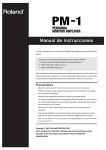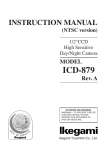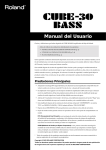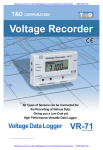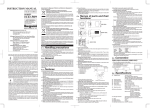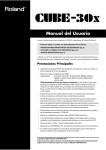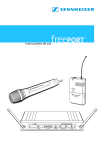Download ICD-48 - Ikegami
Transcript
INSTRUCTION MANUAL B/W CAMERA MODEL ICD-48 OUTDOOR USE WARNING WARNING – TO PREVENT FIRE OR ELECTRIC SHOCK, DO NOT EXPOSED THIS APPLIANCE TO RAIN OR MOISTURE. Ikegami Tsushinki Co., Ltd. Thank you very much for your wise choice of the Ikegami B/W Camera. Please carefully read this Instruction Manual to keep your camera at full capacity. Contents 1. 2. 3. 4. 5. 6. 7. 8. 9. 10. Page Handling precautions ............................................................................... E-1 General .................................................................................................... E-1 Features ................................................................................................... E-1 Names of Parts and their functions .......................................................... E-2 Setting ...................................................................................................... E-5 5-1. User setting ..................................................................................... E-5 5-2. Setting switches and their functions ................................................ E-5 5-3. User setting menus ......................................................................... E-5 Communication Command ...................................................................... E-6 6-1. Communicating conditions .............................................................. E-6 6-2. Command format ............................................................................ E-6 6-3. Communication flow ........................................................................ E-7 6-4. Communication command .............................................................. E-8 6-5. Table of OSD display character codes ............................................ E-9 Specifications ........................................................................................... E-10 Warranty and after-sale service ............................................................... E-11 Appearance View Setup Menu The exclamation point within an equilateral triangle is intended to alert the user to the presence of important operating and maintenance (servicing) instructions in the literature accompanying the appliance. NOTE: This equipment has been tested and found to comply with the limits for a Class A digital device, pursuant to Part 15 of the FCC Rules. These limits are designed to provide reasonable protection against harmful interference when the equipment is operated in a commercial environment. This equipment generates, uses and can radiate radio frequency energy and, if not installed and used in accordance with the instruction manual, may cause harmful interference to radio communications. Operation of this equipment in a residential area is likely to cause harmful interference in which case the user will be required to correct the interference at his own expense. CAUTION; ANY CHANGES OR MODIFICATIONS NOT EXPRESSLY APPROVED BY THE PART RESPONSIBLE FOR COMPLIANCE COULD VOID THE USERS AUTHORITY TO OPERATE THE EQUIPMENT. Instructions for Disposal of Electric and Electronic Equipment in Private Household Disposal of used Electric and Electronic Equipment (Applicable in the European Union and other European countries with separate collection systems) This symbol on the product, or in the related documents in the package, indicates that this product shall not be treated as normal household waste. Instead, it should be taken to a proper applicable collection point or depot for the recycling of electric and electronic equipment. By ensuring this product is disposed of correctly, you will help prevent possible negative consequences for the environment and human health, which could otherwise be caused by inappropriate waste handling of this product. The recycling of materials will help to conserve natural resources. For more detailed information about recycling of this product, please contact your local city authority, your household waste disposal service or the place where you purchased the product. 1. Handling precautions (1)Do not open the case of camera and never touch inside, where precision parts are assembled. A trouble or accident may result. (2)Do not install the unit where it is exposed to water splash, high humidity and heavy dust. Internal parts may be damaged. (3)Be very careful not to drop or shock the camera. (4)Never touch the CCD surface. 2. General This is a B/W camera of high sensitivity, high resolution and high picture quality using a 1/2 inch CCD having high sensitivity to near-infrared ray. It has a high resolution of 570 horizontal lines (EIA), minimum illumination of 0.01 lux, and a smear level of -120 dB, and is equipped with such functions as line lock, automatic electronic shutter, backlight compensation, two-way automatic iris, etc. It is a high utility video camera for monitoring the outdoor scene and as a night-vision camera in combination with near-infrared ray projector. Moreover, since it is endowed with OSD and RS-485 communicating function, a highgrade monitor system architecture is also possible. 3. Features (1) Compactness (2) High sensitivity and high resolution (3) High sensitivity to near-infrared ray (4) Reduced smear (5) Backlight compensation (BLC) (6) Two-way auto iris function (7) Line lock (8) AES (Automatic Electronic Shutter) (9) Flange focal distance adjustment (10) RS-485 communicating function E-1 4. Names of parts and their functions 7 6 2 (LEFT VIEW) 5 (TOP VIEW) 1 3 (RIGHT VIEW) 4 (BACK VIEW) 8 10 9 14 11 15 12 16 19 13 18 E-2 17 ① Lens mount (CS mount) Accepts many types of CS mount lenses. ② C mount adaptor (Accessory) Attached to the lens mount to accept many types of C mount lenses. ③ Flange focal distance adjuster Used to adjust the flange focal distance depending on the type of lens used. Helpful when the lens’ focus ring fails to put into focus. ④ Flange focal distance lock screw Used to mechanically lock the flange focal distance after fine adjustment of it. ⑤ Holder screw hole Used to mount the camera onto the camera holder. Effective for general camera tripods. Note: Be sure to use less than 5.5mm- long setscrew (1/4” – 20 UNC) for mounting the camera to tripods or holder. ⑥ Lens selector switch Used to choose between the video iris and the DC iris depending on the type of auto iris lens used. ⑦ Auto iris lens connector Specifically used to connect the auto iris lens. Use the connector plug that is attached to the camera. • For the video type auto iris lens Set the lens selector switch to VIDEO position. Auto iris lens — Connector cable leads — 4 2 1. Red (power) 2. Not used 3. White (video) 3 1 4. Black (shielded) * Dress the tip of the green lead to prevent a short-circuit. • For the DC type auto iris lens Set the lens selector switch to DC position. — Connector cable leads — 2 1. Damping coil (-) 2. Damping coil (+) 3. Driving coil (+) 4. Driving coil (-) 1 * Connect the leads as shown above. Refer also to the instructions of the lens. Auto iris lens 4 3 3 1 4 2 Numbers of connector pins E-3 ⑧ - ⑫ Camera setting function switches Use them by referring to each operation item. ⑬ Video output terminal Used to give out the video signal. Connect this to the video input terminal of a monitor, switcher etc. (To be terminated with 75-ohm impedance.) ⑭ External sync signal input terminal Used to receive the GENLOCK (general lock) signal. For external synchronization, input VBS or BBS signal. ⑮ External sync signal 75-ohm termination switch Set to HIGH position when the GENLOCK signal is looped with T-shaped connector. Usually, set at 75-OHM position. ⑯ Power indicator Green LED lights up when power is supplied to the camera. ⑰ Terminal switch for RS-485 In RS-485 communication control, turn this switch to ON side for one-to-one control, and turn it to OFF side for daisy-chain connection. (For use in daisy-chain connection, turn ON the terminal switch by terminal connection equipment.) ⑱ RS-485 connection terminal block Used for RS-485 connection. ⑲ AC24V/DC12V power input terminal Input the power of AC21.6~26.4V or DC10.5~15V. ※ This installation should be made by a qualified service person and should conform to all local codes. E-4 5. Setting 5-1. User setting On this camera, user can make settings of picture quality, synchronization, identification etc. by himself or herself. The setup menu is formed in a tree view, and the picture sharpness, synchronization, ID and others can be set up by on-screen characters. (See the setup tree given in the end of this manual.) 5-2. Setting switches and their functions SET UP L U R D E On the back of the camera there are the pushbutton switches and display as shown at the left. UP switch (U): Setting item selection (up) DOWN switch (D):Setting item selection (down) RIGHT switch (R): Setting change and setting item selection (right) LEFT switch (L): Setting change and setting item selection (left) ENTER (E): Setting mode call on/off, setting entry * To enter into the setup mode, keep pressing the E button. 5-3. User setting menus (1)CAMERA ID (2)SHUTTER (3)LIGHT CONT. (4)GAIN (5)SYNC (6)MENU LOCK Up to 16 characters can be accepted and displayed. Switching on and off the CAMERA ID function and presetting ID code characters. Setting of high-speed electronic shutter Selection of high-speed shutter, display of the screen at VARIABLE mode Selection of AES or auto iris lens Setting of back-light compensation as sub-menu Selection of AGC, HYP-AGC and fix Selection of synchronization system (INT, LL) (It is impossible to select LL when the power is not synchronous.) GENLOCK is selected automatically. (GENLOCK is not displayed without external sync signal.) It is possible to adjust the phase on sub-menu. Setting procedure is locked. (Unlocking: U→R→D→L→U →D→E) ● Setting Indications and functions common on the setting menu (1)EXIT Ending (Saving) the setting mode and returning to the regular display. (2)CANCEL Recalling the previously saved settings. (3)RESET Recalling the factory-settings. (4)RET Returning to the preceding setting menu. Select one of these indications and press the E switch. E-5 6. Communication Command 6-1. Communicating conditions (1) Baud rate (2) Data length (3) Parity (4) Stop bit : 9600 bps : 8 bits : None : 1 bit 6-2. Command format 1 2 3 4 5 6 7 8 9 SOH (01h) Receiving model ID Receiving sub ID Transmitting model ID Optional bit function Transmitting sub ID Reservation (80 h) STX (02h) *1 *2 *3 *4 *5 Command (Variable length) n n+1 ETX (03h) n+2 BCC (Exclusive-OR of receiving model ID to ETX) 4th to 7th bytes can be omitted. To the commands omitted of transmitting ID and transmitting sub ID, response is given from camera in the setting as follow: Transmitting model ID omitted → No response from camera Transmitting sub ID omitted → Response is given from camera by transmitting sub ID = 30 h. *1 Transmitting model ID ICD-48...43h *2 Transmitting sub ID ICD-48...Camera No. + 30h (30h ~ FFh) Set the camera No. by “RS-485 ID” items in the special menu for setup. Camera can not be operated unless the settings of “Transmitting sub ID” and “RS-485 ID” are identical. Ex. Camera No. 1 = 31h Camera No. 15 = 3Fh E-6 *3 Transmitting model ID Set the transmitting model ID. (20h ~ 7Dh) Keyboard ID (2Dh) etc. *4 Optional bit function Bit 7 6 5 4 3 2 1 0 Settings Regular 1 Backup Backup Backup Backup Backup Backup Request for ACK/NAK response (0: No, 1: Yes) *5 Transmitting sub ID Set the transmitting sub ID. (30h ~ FFh) 6-3. Communication flow Operating machine ICD-48 Control command ACK Inquiry command ACK Status command E-7 6-4. Communication command Command 1 a b 2 ? Dat 3 4 5 Function 6 Inquiries by type of camera Camera ID display ON/OFF (0:Off, 1:On) Setting of camera ID display position c x1 x2 y1 y2 xx: Horizontal position (07h ~ 3Fh) yy: Vertical position (02h ~ 35h) d Pos Str1 Str2 Str3 Str4 Setting of camera ID display characters Pos: Setting head character position (0h ~ Fh) Str: Character code (20h ~ FFh) g Dat Setting high-speed shutter speed 0:Off, 1:1/100, 2:1/125, 3:250, 4:1/500, 5:1/1000, 6:1/2000, 7:1/4000, 8:1/10000, 9:Variable, A:1/100000 h Dat LENS/AES mode (0:LENS, 1:AES) i Dat Setting of backlight compensation mode (0:Off, 1:On, 2:SPOT) j Dat1 Dat2 Setting of backlight compensation level (40h~BFh) l Dat Gain setting 0:LOW, 1:MID, 2:HIGH, 3:AGC, 4:HYP-AGC o Dat Sync. mode setting (0:INT, 1:LL) p Cor Fin1 Fin2 V-phase setting in LL mode Cor: LL COARSE (0:0°, 1:90°, 2:180°, 3:270°) Fin: LL FINE (00h ~ FFh) q Pha1 Pha2 Setting gain lock H-phase (00h~FFh) u Dat1 Dat2 Detail level setting (00h~0Fh) v Dat1 Dat2 Pedestal level setting (00h~0Fh) w Sw Lock Setting of camera body switch input permission/prohibition Sw: Switch input (0: prohibit, 1: permit) Lock: Setup lock (0: Off, 1: On) x Dat Storage, cancellation and resetting of setting (0: store, 1: cancel, 2: reset) ? Cod Inquiry of setting status 80 Dat1 Dat2 Dat3 Variable shutter speed setting 032h (1/60) ~ 1FFh (1/100000) 82 Dat1 Dat2 DC iris level setting (00h~1Fh) 83 x1 x2 y1 y2 Setting of spot photometric area coordinates xx: abscissa information yy: ordinate information Blank : Space or omittable E-8 Remarks *1 Character code can be designated up to maximum 16 characters. *2 *3 *1 Information of the type and software version of camera and is given. Ex. Inquiry about the type and version of camera for ICD-48 Version 1.00A a? → ICD-48NV1.00A *2 Response to the inquiry about the setting status is given in the format identical to that of each setup expansion command. Ex. Inquiry about the setting of high-speed shutter speed in OFF setting ? g → g0 *3 Spot photometric area coordinates is designated by information of the following settings. However, these settings should be in such combination that the ordinate and abscissa the right end and the bottom should be maximum within Fh. x1 : Ordinate at left end in photometric area (0 ~ Fh) x2 : Width of photometric area (0 ~ Fh) y1 : Abscissa at the top in photometric area (0 ~ Fh) y2 : Height of in photometric area (0 ~ Fh) 6-5. Table of OSD display character codes 2 3 4 5 6 7 0 1 0 1 SP ! 0 1 @ A P Q ` a p q 2 3 4 “ # $ 2 3 4 B C D R S T b c d r s t 5 6 % & 5 6 R F U V e f u v 7 8 ‘ ( 7 8 G H W X g h w x 9 A ) ∗ 9 : I J Y Z i j y z B C → + , ↑ ← K L [ ¥ k l D E ← ↑ – . ↓ → M N ] ^ m n F ↓ / O _ o E-9 7. Specifications (1) (2) (3) (4) (5) (6) Imaging device: Effective pixels: Scanning system: Scanning system: Synchronization system: GENLOCK input: 1/2 inch, IT-CCD 768(H) x 494(V), about 380,000 pixels 2:1 interlace, as per EIA system 525 lines at 59.94 Hz INT, LINE LOCK, GENLOCK VBS or VS; 1.0 Vp-p/75 ohms (High impedance selectable) BBS; 0.45 Vp-p/75 ohms (High impedance selectable) (7) Video output: VS; 1.0 Vp-p/75 ohms (8) Horizontal resolution: 570 TV lines (9) S/N ratio: 50 dB/rms or more (AGC OFF, DETAIL OFF, weighting ON) (10) Minimum illumination: 0.01 lux/F1.4 (AGC ON) (Color temp.: 2856K, Light source: Halogen lamp) (11) Backlight compensation function: ON/OFF switchable (12) AES function: ON/OFF switchable (AES range: About 1 : 1600) (13) High-speed electronic shutter: Make selection among 1/60~1/100,000 sec. , 9-STEP and VARIABLE. In the case of "VARIABLE", it can be set within the range of 1/60~1/100,000 sec. (14) AGC (Automatic gain control): ON (AGC, HYPER AGC)/OFF (LOW, MID, HIGH) switchable (15) Auto iris function: Compatible with video iris and DC iris (selectable) (With DC iris level adjuster) (16) Camera ID function: Provided (One line, 16 characters) (17) Local setting functions: Selectable and adjustable with on-screen display using 5 control buttons; Camera ID, AES/electronic shutter, BLC ON/OFF/SPOT selection and level adjustment, DC iris level, INT/LL, external sync frequency phase adjustment, DETAIL level, AGC ON/OFF, PED. level, menu lock selectable. (18) RS-485 communicating function: Provided Control item: Settable items include local setup function and RS-485 function ID. (19) Lens mount: CS/C mount (with C mount adaptor) (20) Flange focal distance adjuster: Provided (21) Power supply: AC 24V ±10%, 60 Hz/ DC 12V (10.5-15V) (However, the power supply should withstand 48-hour continuous operation at +20%) (22) Power consumption: AC/24V/DC12V: Approx. 4.3W (23) Ambient temp./humidity -10°C to +50°C/Within 30~90%RH for operation: (No dew condensation) E-10 (24) Camera mount: (25) External dimensions: (W x H x D) (26) Weight: (27) I/O connectors: (28) Accessories: 1/4"-20UNC (Attachable on top and bottom.) 62(W) x 55(H) x 118(D) mm (No projections included) Approx. 430 g • VIDEO OUT: BNC • GENLOCK IN: BNC • LENS: 4-pin (Applicable plug: E4-191J-150 or equivalent) • RS-485 communicating: 5 pin push-in terminal • AC 24V/DC 12V input: 2 pin push-in terminal • Instruction manual 1 • C mount adaptor 1 * The specifications and appearance may be subject to change without prior notice. 8. Warranty and after-sale service A warranty accompanies this product. Read and fill out the warranty card that you have received at your dealer. Keep this card in a safe place. • Please consult Ikegami Electronics (U.S.A.), Inc. or your dealer for full warranty information. Your dealer will repair or replace free of charge within the warranty period according to the warranty coverage. • For repairs after the expiration of the warranty period, consult your dealer or sales representative. It will first be judged whether the trouble is repairable or not. Charged servicing will then be made upon the request of user. • Before you ask for servicing, take trouble of reading the Instruction Manual. If the unit still fails, take note of the model number, date of purchase, problem etc. in detail, and inform your dealer or sales representative. • If you have questions about the after-sale service, contact your dealer or sales representative. * We suggest you ask for preventive inspection earlier. E-11 Muchísimas gracias por haber elegido la cámara en N/B de Ikegami. Lea cuidadosamente este manual de instrucciones para mantener su cámara en las mejores condiciones de funcionamiento. Indice 1. 2. 3. 4. 5. 6. 7. 8. 9. 10. Page Precauciones de manejo ......................................................................... S-1 Nociones generales ................................................................................. S-1 Características ......................................................................................... S-1 Nombres de las partes y sus funciones ................................................... S-2 Ajuste ....................................................................................................... S-5 5-1. Ajuste del usuario ............................................................................ S-5 5-2. Conmutadores de ajuste y sus funciones ....................................... S-5 5-3. Menús de ajuste del usuario ........................................................... S-5 Comando de comunicación ..................................................................... S-6 6-1. Condiciones de comunicación ........................................................ S-6 6-2. Formato de comando ...................................................................... S-6 6-3. Flujo de comunicación .................................................................... S-7 6-4. Comando de comunicación ............................................................. S-8 6-5. Tabla de códigos de caracteres de visualización OSD .................... S-9 Especificaciones ...................................................................................... S-10 Garantía y servicio postventa .................................................................. S-12 Appearance View Setup Menu El signo de exclamaci n dentro de un tri ngulo equil tero tiene la finalidad de avisar al usuario de la presencia de instrucciones de funcionamiento y mantenimiento (reparaciones) importantes en los manuales que acompa an al aparato. NOTA: Este equipo ha sido probado y ha demostrado cumplir con los l mites establecidos para los dispositivos digitales de la clase A, de conformidad con el Apartado 15 de las normas de la FCC. Estos l mites han sido establecidos para proporcionar una protecci n razonable contra la interferencia perjudicial cuando el equipo se utiliza en un ambiente comercial. Este equipo genera, utiliza y puede radiar energ a radioel ctrica, y, si no se instala y utiliza seg n las indicaciones del manual de instrucciones, puede causar interferencias perjudiciales en las comunicaciones por radio. El funcionamiento de este equipo en una zona residencial causar probablemente interferencias perjudiciales, en cuyo caso, el usuario tendr que eliminarlas corriendo el mismo con los gastos pertinentes. AVISO: CUALQUIER CAMBIO O MODIFICACI N NO APROBADA EXPRESAMENTE POR LA PARTE RESPONSABLE DEL BUEN FUNCIONAMIENTO DEL APARATO PODRŒA ANULAR LA AUTORIZACI N DEL USUARIO PARA UTILIZAR EL EQUIPO. Instrucciones para eliminar equipos eléctricos y electrónicos de una casa privada Eliminación de equipos eléctricos y electrónicos usados (Normas aplicables en la Unión Europea y en otros países europeos con diferentes sistemas de recogida) Este símbolo en el producto, o en los documentos relacionados, indica que este producto no deberá ser tratado como un residuo doméstico normal. En cambio, deberá ser llevado a un punto o lugar donde los equipos eléctricos y electrónicos sean recogidos para ser reciclados. Asegurándose de que este producto sea eliminado correctamente, usted ayudará a impedir las posibles consecuencias negativas sobre el medio ambiente y la salud humana que podrían ser causadas por el manejo inapropiado de este producto como residuo doméstico. El reciclado de los materiales ayudará a conservar los recursos naturales. Para conocer una información más detallada acerca del reciclado de este producto, póngase en contacto con las autoridades de su localidad, con su servicio de recogida de residuos domésticos o con el comercio donde adquirió el producto. 1. Precauciones de manejo (1)No abra la caja de la cámara ni toque nunca el interior de la misma, donde se encuentran instaladas piezas de alta precisión. De lo contrario podría ocurrir un problema o un accidente. (2)No instale la unidad donde quede expuesta a las salpicaduras del agua, a un humedad alta y al polvo pesado. Las piezas internas pueden dañarse. (3)Tenga cuidado de no dejar caer ni golpear la cámara. (4)No toque nunca la superficie del CCD. 2. Nociones generales Ésta es una cámara en B/N de alta sensibilidad, alta resolución y alta calidad de imagen que emplea un CCD de 1/2 pulgada altamente sensible al rayo infrarrojo próximo. Tiene una resolución alta de 570 líneas horizontales (EIA), una iluminación mínima de 0,01 luxes y un nivel de borrosidad de –120 dB, y está equipada con funciones tales como bloqueo de línea, obturador electrónico automático, compensación de luz de fondo, iris automático de dos vías, etc. Es una videocámara de mucha utilidad para monitorear escenas exteriores y sirve también como una cámara de visión nocturna cuando se combina con un proyector de rayo infrarrojo próximo. Además, como dispone de OSD y función de comunicación RS-485, también es posible disponer de una arquitectura de sistema de monitoreo de alta calidad. 3. Características (1) Compactibilidad (2) Alta sensibilidad y alta resolución (3) Alta sensibilidad al rayo infrarrojo próximo (4) Borrosidad reducida (5) Compensación de luz de fondo (BLC) (6) Función de iris automático de dos vías (7) Bloqueo de línea (8) AES (Obturador electrónico automático) (9) Ajuste de distancia focal de brida (10) Función de comunicación RS-485 S-1 4. Nombres de las partes y sus funciones 7 6 2 (Vista del lado izquierdo) 5 (Vista superior) 1 3 (Vista del lado derecho) 4 (Vista derecha) 8 10 9 14 11 15 12 16 19 13 18 S-2 17 ① Montura del objetivo (montura CS) Acepta muchos tipos de objetivos de montura CS. ② Adaptador de montura C (Accesorio) Se coloca en la montura del objetivo para poder instalar muchos tipos de objetivos de montura C. ③ Ajustador de distancia focal de brida Se utiliza para ajustar la distancia focal de brida dependiendo del tipo de objetivo utilizado. Resulta muy útil cuando el anillo de enfoque del objetivo no puede realizar un enfoque adecuado. ④ Tornillo de bloqueo de distancia focal de brida Se utiliza para bloquear mecánicamente la distancia focal de brida después de haber realizado el ajuste fino de la misma. ⑤ Agujero del tornillo del soporte de la cámara Se utiliza para montar la cámara en su soporte. Resulta muy efectivo para los trípodes de cámaras convencionales. Nota: Asegúrese de utilizar tornillos de fijación de menos de 5,5 mm de longitud (1/4" - 20 UNC) para montar la cámara en trípodes o en el soporte. ⑥ Conmutador selector de objetivo Se utiliza para elegir entre el iris de vídeo y el iris de DC dependiendo del tipo de iris automático que se utilice. ⑦ Conector de objetivo de iris automático Se utiliza específicamente para conectar el objetivo de iris automático. Utilice el conector que está colocada en la cámara. • Para el vídeo del tipo de objetivo de iris automático Ponga el conmutador selector del objetivo en la posición VIDEO. — Conductores de conexión — Objetivo de iris automático 4 2 1. Rojo (alimentación) 2. No se utiliza 3. Blanco (imagen) 3 1 4. Negro (blindado) * Prepare el extremo del cable verde para impedir que se formen cortocircuitos. • Para el objetivo de iris automático tipo DC Ponga el conmutador selector de objetivo en la posición DC. Objetivo de iris automático — Conductores de conexión — 4 2 1. Bobina de amortiguamiento (–) 2. Bobina de amortiguamiento (+) 3. Bobina de excitación (+) 3 1 4. Bobina de excitación (–) * Conecte correctamente los cables como se 3 muestra más arriba consultando las instrucciones del objetivo utilizado. 1 4 2 Número de contactos de conexión S-3 ⑧ - ⑫ Conmutadores de funciones de ajuste de la cámara Utilícelos consultando cada elemento de la operación. ⑬ Terminal de salida de vídeo Se utiliza para dar salida a la señal de vídeo. Conecte este terminal al terminal de entrada de vídeo de un monitor, conmutador, etc. (Será terminado con una impedancia de 75 ohmios.) ⑭ Terminal de entrada de señal de sincronización externa Se utiliza para recibir la señal GENLOCK (bloqueo general). Para la sincronización externa, introduzca una señal VBS o BBS. ⑮ Conmutador de terminación de 75 ohmios para la señal de sincronización externa Póngalo en la posición HIGH cuando la señal GENLOCK se conecte en bucle con el conector en forma de T. Generalmente, póngalo en la posición 75-OHM. ⑯ Indicador de alimentación El LED verde se enciende cuando se suministra alimentación a la cámara. ⑰ Conmutador de terminal para RS-485 En el control de comunicación RS-485, ponga este conmutador en el lado ON para hacer el control uno a uno, y póngalo en el lado OFF para hacer la conexión en cadena tipo margarita. (Para el uso de conexión en cadena tipo margarita, active el conmutador de terminal mediante el equipo de conexión de terminal.) ⑱ Bloque terminal de conexión RS-485 Se usa para la conexión RS-485. ⑲ Terminal de entrada de alimentación CA 24 V/CC 12 V Entrada de alimentación de CA 21,6~26,4 V o CC 10,5~15 V. ※ Esta instalación deberá ser realizada por un técnico cualificado y deberán cumplir con todos los reglamentos locales. S-4 5. Ajuste 5-1. Ajuste del usuario El menú de configuración tiene forma de árbol, y la nitidez de la imagen, la sincronización, la identificación y demás pueden configurarse mediante caracteres en pantalla. (Consulte el árbol de configuración al final de este manual.) 5-2. Conmutadores de ajuste y sus funciones En la parte posterior de la cámara, como se muestra a la izquierda, se encuentran los conmutadores pulsadores y el visualizador. SET UP U L R D E Conmutador UP (U): Selección (ascendente) de elementos de ajuste Conmutador DOWN (D): Selección (descendente) de elementos de ajuste Conmutador RIGHT (R): Cambio de ajuste y selección (hacia la derecha) de elementos de ajuste Conmutador LEFT (L): Cambio de ajuste y selección (hacia la izquierda) de elementos de ajuste ENTER (E): Activación/desactivación de la llamada al modo de ajuste, entrada de ajuste * Para entrar en el modo de configuración, mantenga pulsado el botón E. 5-3. Menús de ajuste del usuario (1)CAMERA ID Se puede aceptar y visualizar un máximo de 16 caracteres. Activación/desactivación de la función CAMERA ID y preajuste de los caracteres del código ID. (2)SHUTTER Ajuste del obturador electrónico de alta velocidad Selección del obturador de alta velocidad, visualización de la pantalla en el modo VARIABLE. (3)LIGHT CONT. Selección de AES o del objetivo de iris automático Ajuste de la compensación de luz de fondo como menú secundario (4)GAIN Selección de AGC, HYP-AGC y fijación (5)SYNC Selección del sistema de sincronización (INT, LL) (No es posible seleccionar LL cuando la alimentación no está sincronizada.) GENLOCK se selecciona automáticamente. (GENKLOCK no se visualiza sin señal de sincronización externa.) En el menú secundario se puede ajustar la fase. (6)MENU LOCK El procedimiento de ajuste se bloquea. (Desbloqueo: U→R→D→L→U→D→E) S-5 ● Ajuste de indicaciones y funciones comunes en el menú de ajuste (1)EXIT Se finaliza (guarda) el modo de ajuste y se vuelve a la visualización convencional. (2)CANCEL Llamada a los ajustes guardados previamente. (3)RESET Recuperación de los ajustes de fábrica. (4)RET Retorno al menú de ajuste anterior. Seleccione una de estas indicaciones y pulse el conmutador E. 6. Comando de comunicación 6-1. Condiciones de comunicación (1) Velocidad de transmisión en baudios (2) Longitud de datos (3) Paridad (4) Bit de parada :9600 bps :8 bits :Ninguna :1 bit 6-2. Formato de comando 1 2 3 4 5 6 7 8 9 SOH (01h) Identificación del modelo de recepción Identificación secundaria de recepción Identificación del modelo de transmisión Función de bit opcional Identificación secundaria de transmisión Reserva (80 h) STX (02h) *1 *2 *3 *4 *5 Comando (Longitud variable) n n+1 ETX (03h) n+2 BCC (Circuito OR exclusivo de identificación del modelo de recepción a ETX) Se pueden omitir los bytes 4to. a 7mo. A los comandos omitidos de la identificación de transmisión e identificación secundaria de transmisión, la respuesta se da desde la cámara con el ajuste siguiente: Identificación de modelo de transmisión omitida → No hay respuesta desde la cámara Identificación secundaria de transmisión omitida → Hay respuesta desde la cámara mediante la identificación secundaria de transmisión = 30 h. S-6 *1 Identificación del modelo de transmisión *2 Identificación secundaria de transmisión ICD-48...43h ICD-48...N.° de cámara + 30h (30h ~ FFh) Ponga el número de la cámara mediante los elementos “RS-485 ID” en el menú especial para instalación. La cámara no se podrá utilizar a menos que los ajustes de “Identificación secundaria de transmisión” y “RS-485 ID” sean idénticos. Ejemplo: Cámara N.° 1 = 31h Cámara N.° 15 = 3Fh *3 Identificación del modelo de transmisión: Ponga la identificación del modelo de transmisión. (20h ~ 7Dh) Identificación de teclado (2Dh), etc. *4 Función de bit opcional Bit 7 6 5 4 3 2 1 0 Ajustes Regular 1 Apoyo Apoyo Apoyo Apoyo Apoyo Apoyo Solicitud de respuesta ACK/NAK (0: No, 1: Sí) *5 Identificación secundaria de transmisión transmisión. (30h ~ FFh) Ponga la identificación secundaria de 6-3. Flujo de comunicación Máquina en funcionamiento ICD-48 Comando de control ACK Comando de pregunta ACK Comando de estado S-7 6-4. Comando de comunicación 1 a b 2 ? Dat Comando 3 4 5 Función 6 Preguntas por tipo de cámara Encendido/Apagado de visualización de identificación de cámara (0:OFF, 1:ON) c x1 x2 y1 y2 Ajuste de la posición de visualización de identificación de cámara xx: Posición horizontal (07h ~ 3Fh) yy: Posición vertical (02h ~ 35h) d Pos Str1 Str2 Str3 Str4 Ajuste de los caracteres de visualización de identificación de cámara Pos: Ajuste de la posición de caracteres de encabezamiento (0h ~ Fh) Str: Código de caracteres (20h ~ FFh) g Dat Ajuste de la velocidad del obturador de alta velocidad 0:Off, 1:1/100, 2:1/125, 3:250, 4:1/500, 5:1/1000, 6:1/2000, 7:1/4000, 8:1/10000, 9:Variable, A:1/100000 h Dat Modo LENS/AES (0:LENS, 1:AES) i Dat Ajuste del modo de compensación de luz de fondo (0:OFF, 1:ON, 2:SPOT) Ajuste del nivel de compensación de luz de fondo j Dat1 Dat2 (40h~BFh) l Dat Ajuste de ganancia 0:LOW, 1:MID, 2:HIGH, 3:AGC, 4:HYP-AGC o Dat Ajuste del modo de sincronización (0:INT, 1:LL) p Cor Fin1 Fin2 Ajuste de fase V en el modo LL Cor: LL COARSE (0:0°, 1:90°, 2:180°,3:270°) Fin: LL FINE (00h ~ FFh) Ajuste de fase H del bloqueo de ganancia q Pha1 Pha2 (00h~FFh) u Dat1 Dat2 Ajuste del nivel de detalle (00h~0Fh) v Dat1 Dat2 Ajuste del nivel de pedestal (00h~0Fh) Ajuste de permiso/prohibición de entrada del w Sw Lock conmutador del cuerpo de la cámara Sw: Entrada de conmutador (0: prohibida, 1: permitida) Lock: Bloqueo de instalación (0: Off, 1: On) Almacenamiento, cancelación y reposición de x Dat ajuste (0: almacenar, 1: cancelar, 2: reponer) ? Cod Pregunta del estado del ajuste Ajuste de velocidad de obturador variable 80 Dat1 Dat2 Dat3 032h (1/60) ~ 1FFh (1/100000) 82 Dat1 Dat2 Ajuste de nivel de iris DC (00h~1Fh) 83 x1 x2 y1 y2 Ajuste de coordenadas de área fotométrica de punto xx: información de abscisa yy: información de ordenada En blanco : Espacio o se puede omitir S-8 Observaciones *1 El código de caracteres se puede designar con un máximo de 16 caracteres. *2 *3 *1 Se da información del tipo y versión de software de la cámara. Ejemplo: Pregunta acerca del tipo y versión de cámara para ICD-48 Version 1.00A a? → ICD-48NV1.00A *2 Se da respuesta a la pregunta acerca del estado del ajuste en formato idéntico al de cada comando de expansión de instalación. Ejemplo: Pregunta acerca del ajuste de velocidad del obturador de alta velocidad en OFF ? g → g0 *3 Las coordenadas del área fotométrica de punto se designan mediante la información de los ajustes siguientes. Sin embargo, estos ajustes deberán estar combinados de tal forma que la ordenada y la abscisa en el extremo derecho y en la parte inferior sean las máximas dentro de Fh. x1 : Ordenada en el extremo izquierdo del área fotométrica (0 ~ Fh) x2 : Anchura del área fotométrica (0 ~ Fh) y1 : Abscisa en la parte superior del área fotométrica (0 ~ Fh) y2 : Altura en el área fotométrica (0 ~ Fh) 6-5. Tabla de códigos de caracteres de visualización OSD 0 0 1 2 SP 3 0 4 @ 5 P 6 ` 7 p 1 2 ! “ 1 2 A B Q R a b q r 3 4 # $ 3 4 C D S T c d s t 5 6 % & 5 6 R F U V e f u v 7 8 ‘ ( 7 8 G H W X g h w x 9 A ) ∗ 9 : I J Y Z i j y z B C → + , ↑ ← K L [ ¥ k l D E ← ↑ – . ↓ → M N ] ^ m n F ↓ / O _ o S-9 7. Especificaciones (1) (2) (3) (4) (5) (6) Dispositivo de formación de imagen: Píxeles efectivos: Sistema de exploración: Sistema de exploración Sistema de sincronización: Entrada GENLOCK: (7) Salida de vídeo: (8) Resolución horizontal: (9) Relación señal/ruido: (10) Iluminación mínima: (11) Función de compensación de luz de fondo: (12) Función AES: 1/2 pulgada, IT-CCD 768 (H) x 494 (V), unos 380.000 píxeles Entrelazado 2:1, como el sistema EIA 525 líneas a 59,94 Hz INT, Bloqueo de línea, GENLOCK VBS o VS; 1,0 Vp-p/75 ohmios (alta impedancia seleccionable) BBS; 0,45 Vp-p/75 ohmios (alta impedancia seleccionable) VS; 1,0 Vp-p/75 ohmios 570 líneas 50 dB/rms o más (AGC OFF, DETAIL OFF, ponderación activada) 0,01 luxes/F1.4 (Temperatura del color: 2856K, fuente de luz: Lámpara halógena) ON/OFF, conmutable ON/OFF, conmutable (Gama AES: 1 : 1.600 aproximadamente) (13) Obturador electrónico de alta velocidad: Seleccione entre 1/60~1/100.000 de segundo, 9STEP y VARIABLE. En el caso de “VARIABLE”, se puede ajustar un valor cualquiera dentro del margen de 1/60~ 1/100.000 segundos. (14) AGC (Control de ganancia automática): ON (AGC,HYPER AGC)/OFF (LOW, MID, HIGH), conmutable (15) Función de iris automático: Compatible con iris de vídeo e iris DC (seleccionable) (Con regulador de nivel de iris DC) (16) Función de identificación de cámara: Provista (Una línea, 16 caracteres) (17) Funciones de ajuste local: Seleccionables y ajustables con la visualización en pantalla utilizando 5 botones de control; identificación de cámara, AES/obturador electrónico, selección BLC ON/OFF/SPOT y ajuste de nivel, nivel de iris DC, INT/LL, ajuste de fase de frecuencia de sincronización externa, nivel DETAIL, AGC ON/OFF, nivel PED., bloqueo de menú seleccionable. (18) Función de comunicación RS-485: Provista Elemento de control: Entre los elementos que se pueden configurar se incluye la función de configuración local y la identificación de la función RS-485. (19) Montura de objetivo: Montura CS/C (con adaptador para montura C) (20) Regulador de distancia focal de brida: Suministrado S-10 (21) Alimentación: (22) Consumo: (23) Temperatura/humedad ambiental de funcionamiento: (24) Montura de cámara: (25) Dimensiones externas: (An x Al x Prof) (26) Peso: (27) Conectores de entrada/salida: (29) Accesorios 24 V CA ±10%, 60 Hz / 12 V CC (10,5-15 V) (Sin embargo, la alimentación deberá ser capaz de resistir un funcionamiento continuo de 48 horas a +20%) 24 V CA/12 V CC: Aproximadamente 4,3 W –10°C a +50°C/Dentro del 30~90% de humedad relativa (Sin condensación de humedad) 1/4"–20UNC (Se puede colocar en la parte superior e inferior.) 62 (An) x 55 (Al) x 118 (Prof) mm (Sin incluir proyecciones) Aproximadamente 430 g • VIDEO OUT: BNC • GENLOCK IN: BNC • LENS: 4 contactos (Clavija aplicable: E4-191J-150 o equivalente) • Comunicación RS-485: Terminal de encaje de 5 contactos • Entrada de 24 V CA/12 V CC: Terminal de encaje de 2 contactos • Manual de instrucciones 1 • Adaptador de montura C 1 * Las especificaciones y la apariencia pueden estar sujetas a cambios sin previo aviso. S-11 8. Garantía y servicio postventa Este producto va acompañado de una garantía. Lea y rellene la tarjeta de garantía que le ha entregado su concesionario. Guarde esta tarjeta en un lugar seguro. • Consulte a Ikegami Electronics (U.S.A.) Inc. o a su concesionario para obtener información completa acerca de la garantía. Su concesionario hará gratis las reparaciones o reemplazos que necesite su aparato siempre que la garantía esté vigente y se cumplan las condiciones de la misma. • Para hacer reparaciones una vez caducada la garantía, consulte a su concesionario o representante de ventas. Primero se tendrá en consideración si el problema puede ser reparado o no. Y luego se le indicará al usuario el coste del servicio si éste así lo solicita. • Antes de solicitar el servicio de reparaciones, lea con atención el manual de instrucciones. Si no puede solucionar el problema, anote el número del modelo y la fecha de adquisición, describa con todo detalle el problema, etc. e informe a su concesionario o representante de ventas. • Si tiene alguna pregunta relacionada con el servicio postventa, consulte a su concesionario o representante de ventas. * Le sugerimos que solicite siempre una inspección preventiva. S-12 55 9. Appearance View 1"-32UN-2B 62 C MOUNT ADAPTOR (ACCESSORY) 2-1/4"-20UNC I KEGAMI TSUSHINKI CO., LTD. MADE IN JAPAN GENLOCK IN SET UP L U R D E HIGH 75‰ POWER VIDEO OUT DC12V3.9W AC24V60Hz4.3W TERM OFF ON RS-485 – + –+–+ GND CLASS 2 LENS DC Digital Digital V I D E O CAMERA B/W CAMERA TYPE MODEL ICD – 48 AC 24 V 60 Hz 4.3 W/DC 12 V 3.9 W REV. SER. NO. DATE V I D E O CAMERA 118 5C46 VIDEO Max40mA FOCUS ADJ LOCK COMMERCIAL CCTV PRODUCT ¤ THIS DEVICE COMPLIES WITH PART 15 OF THE FCC RULES. OPERATION IS SUBJECT TO THE FOLLOWING TWO CONDITIONS: (1) THIS DEVICE MAY NOT CAUSE HARMFUL INTERFERENCE. AND (2) THIS DEVICE MUST ACCEPT ANY INTERFERENCE RECEIVED. INCLUDING INTERFERENCE THAT MAY CAUSE UNDESIRED OPERATION. SETUP MENU PUSH E FOR A WHILE D R GAIN LOW MID HIGH AGC HYP-AGC +E AES +E +E R LENS D LIGHT CONT. L U OFF 1/100 1/125 1/250 1/500 1/1000 1/2000 1/4000 1/10000 1/100000 VARIABLE ON OFF TOP SHUTTER CAMERA ID L U *ALPHANUMERIC *POSITION RET L D U R +E D R +E SPOT +E +E *ADJUST EXIT SPOT SET IRIS LEVEL RET +E +E *ADJUST R BLC LEVEL +E *ADJUST EXIT *ADJUST *ADJUST EXIT D IRIS LEVEL +E +E L U RET BLC LEVEL R IRIS LEVEL D OFF RET L U ON +D *ADJUST 1/60 - 1/100000 EXIT L U 2ND D U *ADJUST L R 3RD 10. Setup Menu OFF CANCEL RESET MENU LOCK EXIT TOP PUSH L AND R AT ONCE SPECIAL MENU EXT VS LL INT AUTO-CHANGE SYNC +E +E +E +E *BEFORE SETTING *DEFAULT ON +URDLUDE EXIT RET 2ND ENGLISH FRANCAIS LANGUAGE +E *ADJUST *ADJUST SETTING (001-207) +E +E DETAIL PEDESTAL RS-485 ID +E *ADJUST EXIT H.PHASE RET +E EXIT RET +E *ADJUST *ADJUST COARSE FINE EXT VS RET +E EXIT +E 3RD Ikegami Electronics (U.S.A.), Inc. 37 Brook Avenue, Maywood, New Jersey 07607, U.S.A. Phone: (201) 368-9171, FAX 201-569-1626 Ikegami Electronics (Europe) GmbH Ikegami Strasse 1, 41460 Neuss 1, F.R. Germany TEL. 02131-123-0/FAX 02131-102820 Ikegami Electronics (Europe) GmbH U.K. Branch Unit E1 Cologne Court Brooklands Close, Windmill Road Sunbury-on-Thames Middlesex TW16 7EB, UK TEL. 01932-769700/FAX 01-92-769710 Ikegami Tsushinki Co., Ltd. Printed in Japan. K35209































